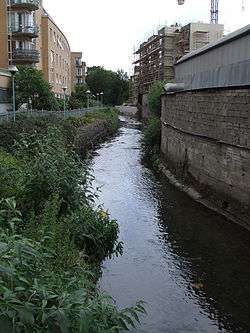River Camac
| River Camac | |
|---|---|
|
Camac River looking south at Inchicore by "The Tramyard" development | |
| Basin | |
| Main source | Mount Seskin, Slade of Saggart |
| River mouth | River Liffey at Heuston Station, ultimately Dublin Bay |
| River system | River Liffey |
| Features | |
| Tributaries |
|
The River Camac (sometimes spelled Cammock, or, historically, Cammoge or Cammoke; Irish: An Chamóg or Abhainn na Camóige) is one of the larger rivers in Dublin and was one of four tributaries of the Liffey critical to the early development of the city.
Course
The Camac forms from a flow from Mount Seskin southeast of Saggart, to the southwest of Dublin city, and other mountain streams as well as an 18th-century diversion from the Brittas River tributary of the River Liffey.[1] It flows through a mountain valley, the Slade of Saggart, southwest of the broad Tallaght area and east of Newcastle, then past Saggart, through Corkagh Park and then Clondalkin, near which it is sometimes called Clondalkin River. The Camac then continues on to Inchicore where it is tunnelled under the Grand Canal before a bridge crossing at Golden Bridge, and Kilmainham, where it runs behind the jail museum, before entering the Liffey alongside Heuston Station, a little upstream of Sean Heuston Bridge. The river was tunnelled underneath the railway station when it was built in 1846.
The Camac runs behind Richmond Park, home to St Patrick's Athletic and gives its name to the ground's 'Camac Terrace'.
Tributaries
The Camac receives tributaries in the Slade of Saggart, including the Ferny Glinn and the Two Slades, and later from around Newcastle, and near Clondalkin (including the Boherboy, Brownsbarn and Fettercairn Streams, the latter joining near the boundary of Corkagh Park, in which the Camac features). Lower tributaries include the Robinhood Stream (Coolfan River), Gallblack Stream (formed from the Blackditch and Gallanstown Streams), Drimnagh Castle (or Bluebell) Stream, and Walkinstown Stream.
References
- ↑ Doyle (2011), p. 17
Bibliography
| Wikimedia Commons has media related to River Camac. |
- Doyle, Joseph W. (2011) [2008]. Ten Dozen Waters: The Rivers and Streams of County Dublin (3rd edition). Dublin, Ireland: Rath Eanna Research. pp. 1–30 + ii + map. ISBN 978-0-9566363-1-7.
- Sweeney, Clair L. (1991). The Rivers of Dublin. Dublin, Ireland: Dublin Corporation. pp. 1–115, inc. many maps. ISBN 0-9505301-4-X.
